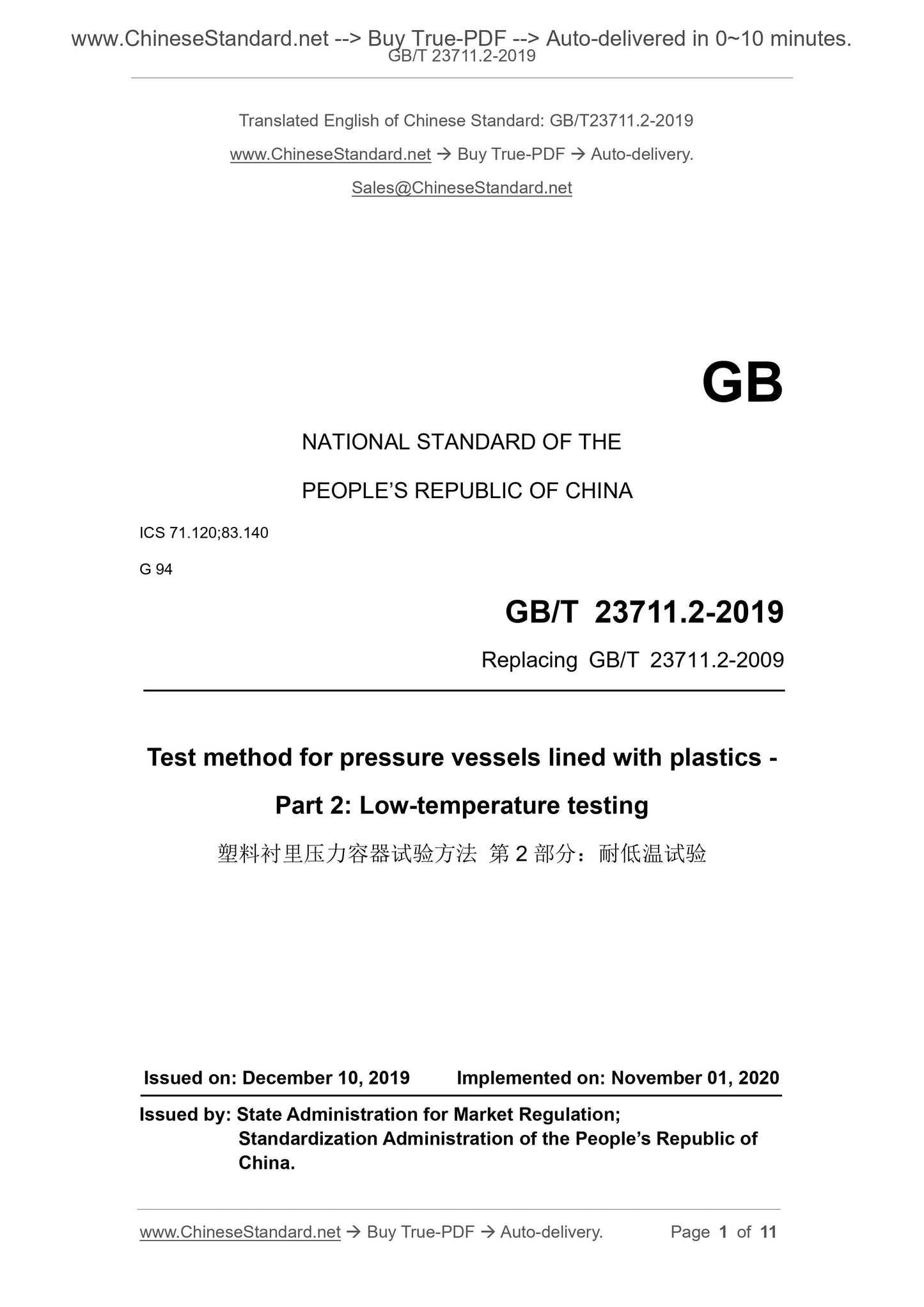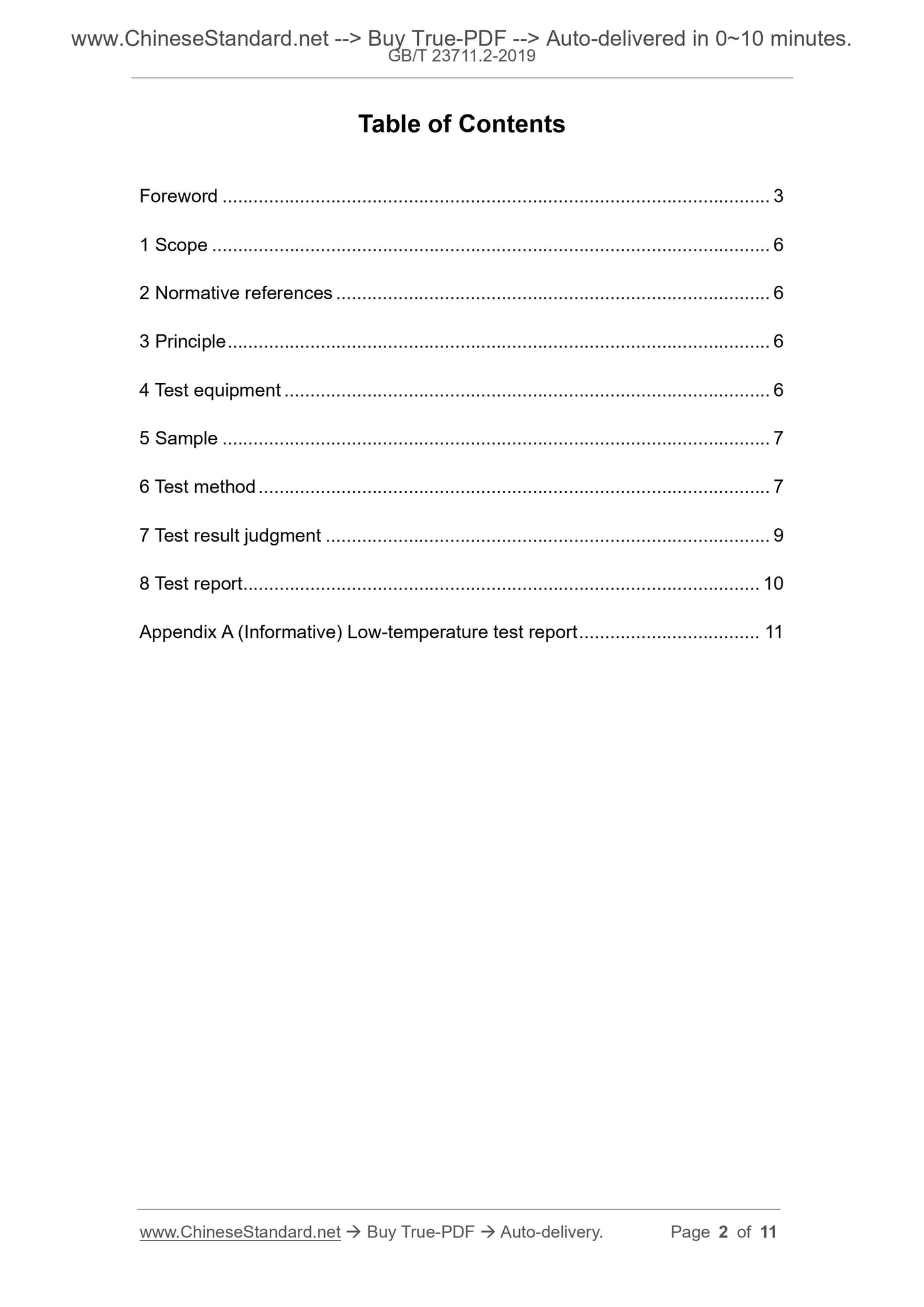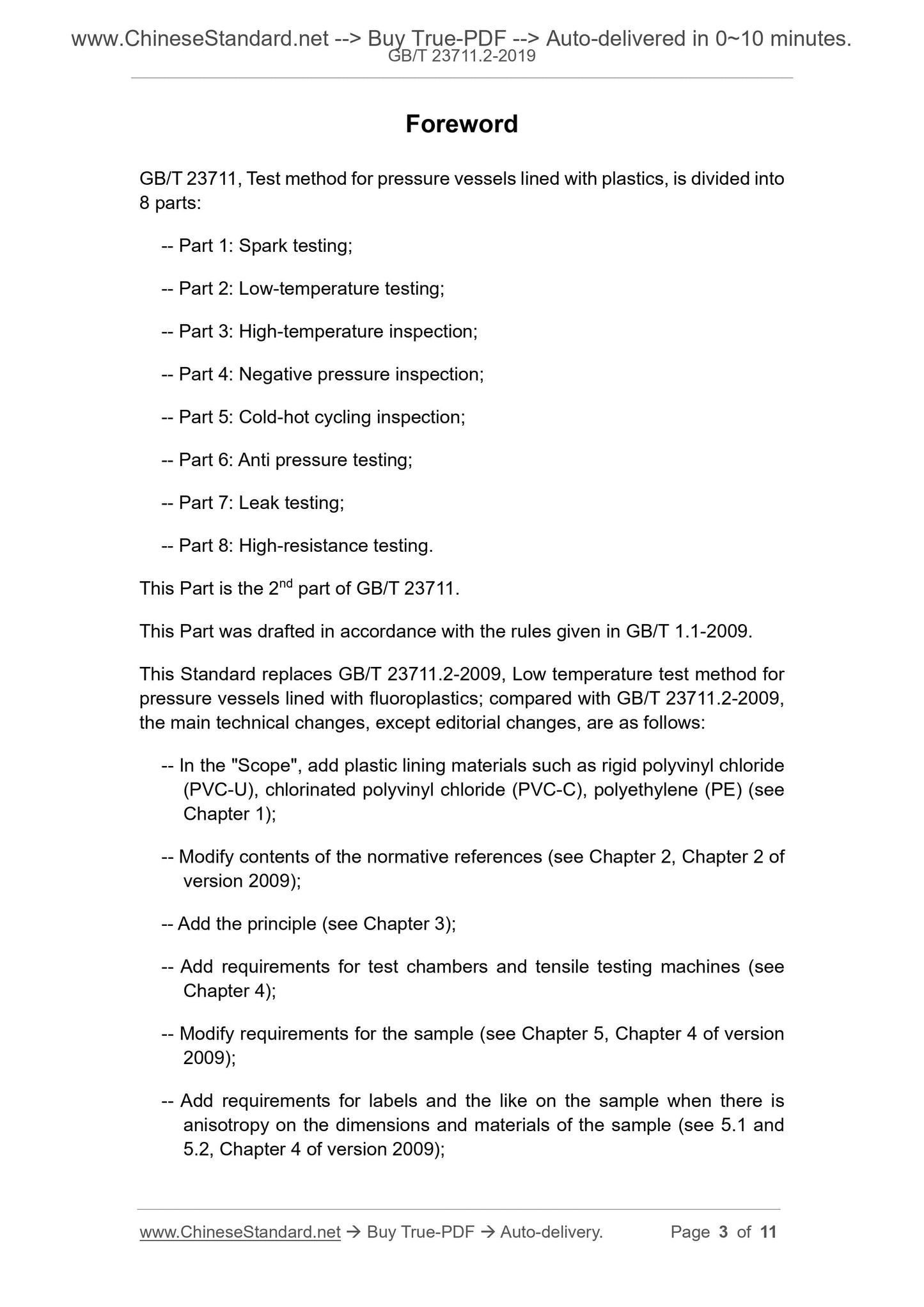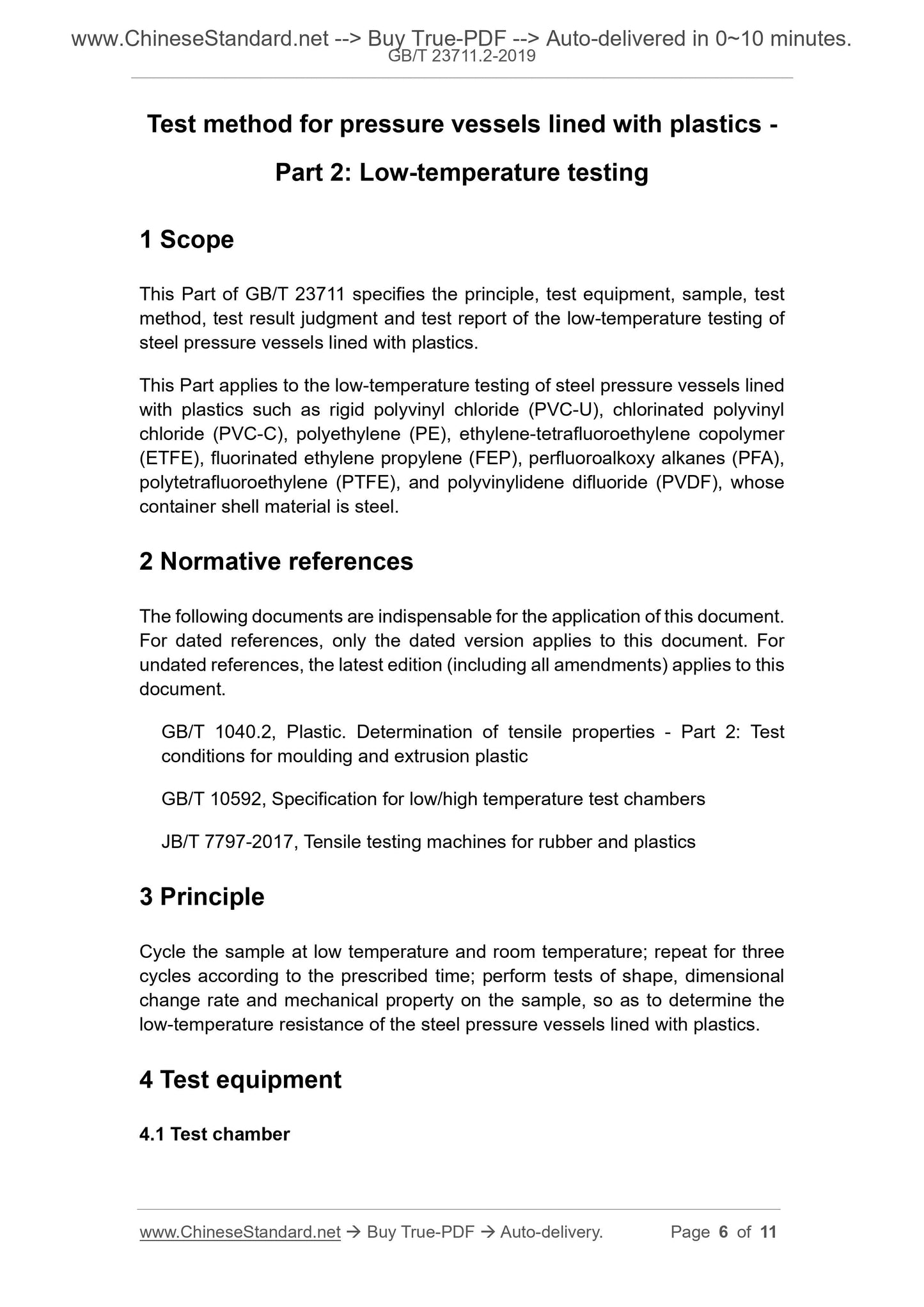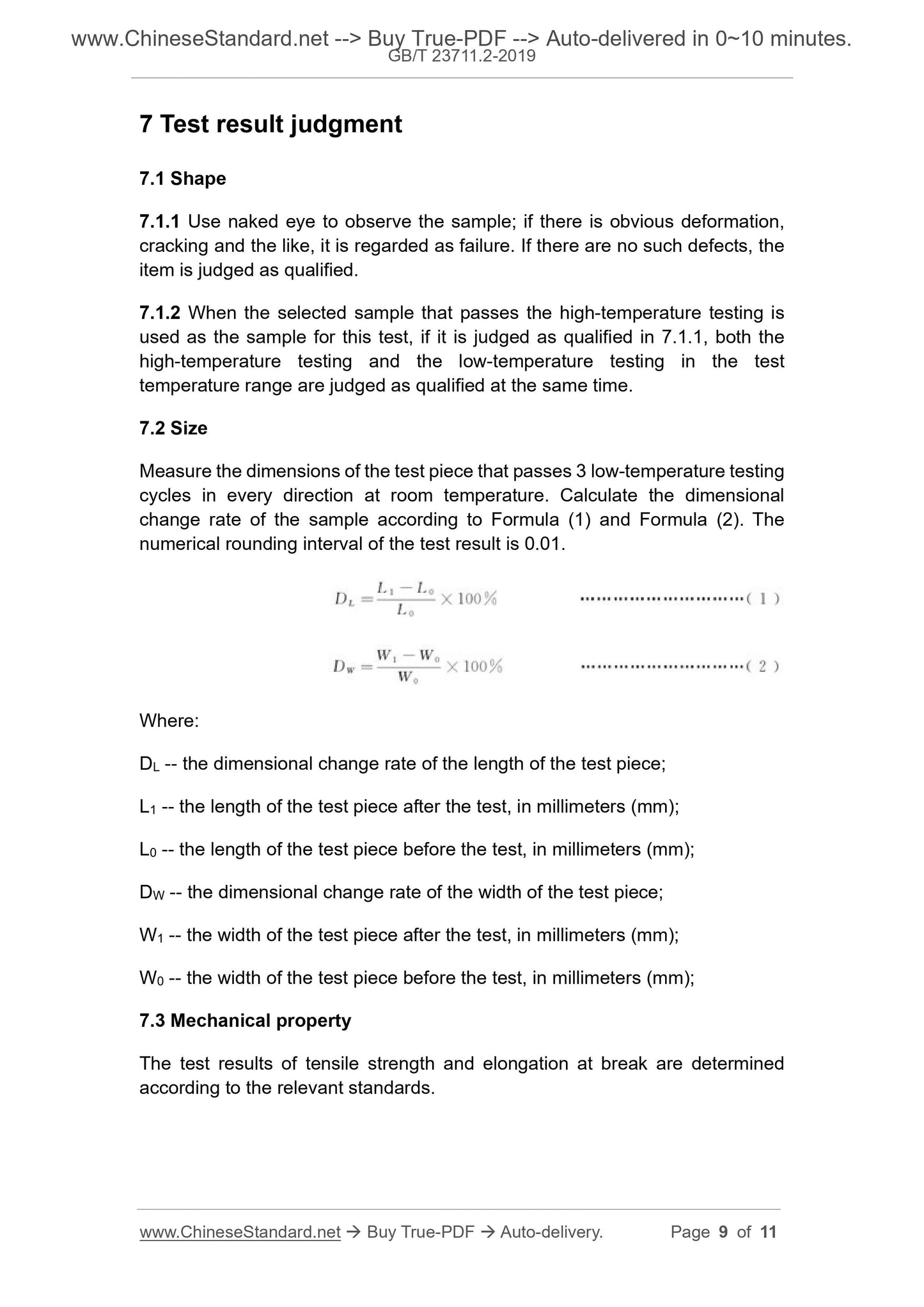1
/
of
5
www.ChineseStandard.us -- Field Test Asia Pte. Ltd.
GB/T 23711.2-2019 English PDF (GB/T23711.2-2019)
GB/T 23711.2-2019 English PDF (GB/T23711.2-2019)
Regular price
$175.00
Regular price
Sale price
$175.00
Unit price
/
per
Shipping calculated at checkout.
Couldn't load pickup availability
GB/T 23711.2-2019: Test method for pressure vessels lined with plastics - Part 2: Low-temperature testing
Delivery: 9 seconds. Download (& Email) true-PDF + Invoice.
Get Quotation: Click GB/T 23711.2-2019 (Self-service in 1-minute)
Historical versions (Master-website): GB/T 23711.2-2019
Preview True-PDF (Reload/Scroll-down if blank)
GB/T 23711.2-2019
NATIONAL STANDARD OF THE
PEOPLE’S REPUBLIC OF CHINA
ICS 71.120;83.140
G 94
Replacing GB/T 23711.2-2009
Test method for pressure vessels lined with plastics -
Part 2: Low-temperature testing
ISSUED ON: DECEMBER 10, 2019
IMPLEMENTED ON: NOVEMBER 01, 2020
Issued by: State Administration for Market Regulation;
Standardization Administration of the People’s Republic of
China.
Table of Contents
Foreword ... 3
1 Scope ... 6
2 Normative references ... 6
3 Principle ... 6
4 Test equipment ... 6
5 Sample ... 7
6 Test method ... 7
7 Test result judgment ... 9
8 Test report ... 10
Appendix A (Informative) Low-temperature test report ... 11
Foreword
GB/T 23711, Test method for pressure vessels lined with plastics, is divided into
8 parts:
-- Part 1: Spark testing;
-- Part 2: Low-temperature testing;
-- Part 3: High-temperature inspection;
-- Part 4: Negative pressure inspection;
-- Part 5: Cold-hot cycling inspection;
-- Part 6: Anti pressure testing;
-- Part 7: Leak testing;
-- Part 8: High-resistance testing.
This Part is the 2nd part of GB/T 23711.
This Part was drafted in accordance with the rules given in GB/T 1.1-2009.
This Standard replaces GB/T 23711.2-2009, Low temperature test method for
pressure vessels lined with fluoroplastics; compared with GB/T 23711.2-2009,
the main technical changes, except editorial changes, are as follows:
-- In the "Scope", add plastic lining materials such as rigid polyvinyl chloride
(PVC-U), chlorinated polyvinyl chloride (PVC-C), polyethylene (PE) (see
Chapter 1);
-- Modify contents of the normative references (see Chapter 2, Chapter 2 of
version 2009);
-- Add the principle (see Chapter 3);
-- Add requirements for test chambers and tensile testing machines (see
Chapter 4);
-- Modify requirements for the sample (see Chapter 5, Chapter 4 of version
2009);
-- Add requirements for labels and the like on the sample when there is
anisotropy on the dimensions and materials of the sample (see 5.1 and
5.2, Chapter 4 of version 2009);
Test method for pressure vessels lined with plastics -
Part 2: Low-temperature testing
1 Scope
This Part of GB/T 23711 specifies the principle, test equipment, sample, test
method, test result judgment and test report of the low-temperature testing of
steel pressure vessels lined with plastics.
This Part applies to the low-temperature testing of steel pressure vessels lined
with plastics such as rigid polyvinyl chloride (PVC-U), chlorinated polyvinyl
chloride (PVC-C), polyethylene (PE), ethylene-tetrafluoroethylene copolymer
(ETFE), fluorinated ethylene propylene (FEP), perfluoroalkoxy alkanes (PFA),
polytetrafluoroethylene (PTFE), and polyvinylidene difluoride (PVDF), whose
container shell material is steel.
2 Normative references
The following documents are indispensable for the application of this document.
For dated references, only the dated version applies to this document. For
undated references, the latest edition (including all amendments) applies to this
document.
GB/T 1040.2, Plastic. Determination of tensile properties - Part 2: Test
conditions for moulding and extrusion plastic
GB/T 10592, Specification for low/high temperature test chambers
JB/T 7797-2017, Tensile testing machines for rubber and plastics
3 Principle
Cycle the sample at low temperature and room temperature; repeat for three
cycles according to the prescribed time; perform tests of shape, dimensional
change rate and mechanical property on the sample, so as to determine the
low-temperature resistance of the steel pressure vessels lined with plastics.
4 Test equipment
4.1 Test chamber
7 Test result judgment
7.1 Shape
7.1.1 Use naked eye to observe the sample; if there is obvious deformation,
cracking and the like, it is regarded as failure. If there are no such defects, the
item is judged as qualified.
7.1.2 When the selected sample that passes the high-temperature testing is
used as the sample for this test, if it is judged as qualified in 7.1.1, both the
high-temperature testing and the low-temperature testing in the test
temperature range are judged as qualified at the same time.
7.2 Size
Measure the dimensions of the test piece that passes 3 low-temperature testing
cycles in every direction at room temperature. Calculate the dimensional
change rate of the sample according to Formula (1) and Formula (2). The
numerical rounding interval of the test result is 0.01.
Where:
DL -- the dimensional change rate of the length of the test piece;
L1 -- the length of the test piece after the test, in millimeters (mm);
L0 -- the length of the test piece before the test, in millimeters (mm);
DW -- the dimensional change rate of the width of the test piece;
W1 -- the width of the test piece after the test, in millimeters (mm);
W0 -- the width of the test piece before the test, in millimeters (mm);
7.3 Mechanical property
The test results of tensile strength and elongation at break are determined
according to the relevant standards.
GB/T 23711.2-2019
NATIONAL STANDARD OF THE
PEOPLE’S REPUBLIC OF CHINA
ICS 71.120;83.140
G 94
Replacing GB/T 23711.2-2009
Test method for pressure vessels lined with plastics -
Part 2: Low-temperature testing
ISSUED ON: DECEMBER 10, 2019
IMPLEMENTED ON: NOVEMBER 01, 2020
Issued by: State Administration for Market Regulation;
Standardization Administration of the People’s Republic of
China.
Table of Contents
Foreword ... 3
1 Scope ... 6
2 Normative references ... 6
3 Principle ... 6
4 Test equipment ... 6
5 Sample ... 7
6 Test method ... 7
7 Test result judgment ... 9
8 Test report ... 10
Appendix A (Informative) Low-temperature test report ... 11
Foreword
GB/T 23711, Test method for pressure vessels lined with plastics, is divided into
8 parts:
-- Part 1: Spark testing;
-- Part 2: Low-temperature testing;
-- Part 3: High-temperature inspection;
-- Part 4: Negative pressure inspection;
-- Part 5: Cold-hot cycling inspection;
-- Part 6: Anti pressure testing;
-- Part 7: Leak testing;
-- Part 8: High-resistance testing.
This Part is the 2nd part of GB/T 23711.
This Part was drafted in accordance with the rules given in GB/T 1.1-2009.
This Standard replaces GB/T 23711.2-2009, Low temperature test method for
pressure vessels lined with fluoroplastics; compared with GB/T 23711.2-2009,
the main technical changes, except editorial changes, are as follows:
-- In the "Scope", add plastic lining materials such as rigid polyvinyl chloride
(PVC-U), chlorinated polyvinyl chloride (PVC-C), polyethylene (PE) (see
Chapter 1);
-- Modify contents of the normative references (see Chapter 2, Chapter 2 of
version 2009);
-- Add the principle (see Chapter 3);
-- Add requirements for test chambers and tensile testing machines (see
Chapter 4);
-- Modify requirements for the sample (see Chapter 5, Chapter 4 of version
2009);
-- Add requirements for labels and the like on the sample when there is
anisotropy on the dimensions and materials of the sample (see 5.1 and
5.2, Chapter 4 of version 2009);
Test method for pressure vessels lined with plastics -
Part 2: Low-temperature testing
1 Scope
This Part of GB/T 23711 specifies the principle, test equipment, sample, test
method, test result judgment and test report of the low-temperature testing of
steel pressure vessels lined with plastics.
This Part applies to the low-temperature testing of steel pressure vessels lined
with plastics such as rigid polyvinyl chloride (PVC-U), chlorinated polyvinyl
chloride (PVC-C), polyethylene (PE), ethylene-tetrafluoroethylene copolymer
(ETFE), fluorinated ethylene propylene (FEP), perfluoroalkoxy alkanes (PFA),
polytetrafluoroethylene (PTFE), and polyvinylidene difluoride (PVDF), whose
container shell material is steel.
2 Normative references
The following documents are indispensable for the application of this document.
For dated references, only the dated version applies to this document. For
undated references, the latest edition (including all amendments) applies to this
document.
GB/T 1040.2, Plastic. Determination of tensile properties - Part 2: Test
conditions for moulding and extrusion plastic
GB/T 10592, Specification for low/high temperature test chambers
JB/T 7797-2017, Tensile testing machines for rubber and plastics
3 Principle
Cycle the sample at low temperature and room temperature; repeat for three
cycles according to the prescribed time; perform tests of shape, dimensional
change rate and mechanical property on the sample, so as to determine the
low-temperature resistance of the steel pressure vessels lined with plastics.
4 Test equipment
4.1 Test chamber
7 Test result judgment
7.1 Shape
7.1.1 Use naked eye to observe the sample; if there is obvious deformation,
cracking and the like, it is regarded as failure. If there are no such defects, the
item is judged as qualified.
7.1.2 When the selected sample that passes the high-temperature testing is
used as the sample for this test, if it is judged as qualified in 7.1.1, both the
high-temperature testing and the low-temperature testing in the test
temperature range are judged as qualified at the same time.
7.2 Size
Measure the dimensions of the test piece that passes 3 low-temperature testing
cycles in every direction at room temperature. Calculate the dimensional
change rate of the sample according to Formula (1) and Formula (2). The
numerical rounding interval of the test result is 0.01.
Where:
DL -- the dimensional change rate of the length of the test piece;
L1 -- the length of the test piece after the test, in millimeters (mm);
L0 -- the length of the test piece before the test, in millimeters (mm);
DW -- the dimensional change rate of the width of the test piece;
W1 -- the width of the test piece after the test, in millimeters (mm);
W0 -- the width of the test piece before the test, in millimeters (mm);
7.3 Mechanical property
The test results of tensile strength and elongation at break are determined
according to the relevant standards.
Delivery: 9 seconds. Download (& Email) true-PDF + Invoice.
Get Quotation: Click GB/T 23711.2-2019 (Self-service in 1-minute)
Historical versions (Master-website): GB/T 23711.2-2019
Preview True-PDF (Reload/Scroll-down if blank)
GB/T 23711.2-2019
NATIONAL STANDARD OF THE
PEOPLE’S REPUBLIC OF CHINA
ICS 71.120;83.140
G 94
Replacing GB/T 23711.2-2009
Test method for pressure vessels lined with plastics -
Part 2: Low-temperature testing
ISSUED ON: DECEMBER 10, 2019
IMPLEMENTED ON: NOVEMBER 01, 2020
Issued by: State Administration for Market Regulation;
Standardization Administration of the People’s Republic of
China.
Table of Contents
Foreword ... 3
1 Scope ... 6
2 Normative references ... 6
3 Principle ... 6
4 Test equipment ... 6
5 Sample ... 7
6 Test method ... 7
7 Test result judgment ... 9
8 Test report ... 10
Appendix A (Informative) Low-temperature test report ... 11
Foreword
GB/T 23711, Test method for pressure vessels lined with plastics, is divided into
8 parts:
-- Part 1: Spark testing;
-- Part 2: Low-temperature testing;
-- Part 3: High-temperature inspection;
-- Part 4: Negative pressure inspection;
-- Part 5: Cold-hot cycling inspection;
-- Part 6: Anti pressure testing;
-- Part 7: Leak testing;
-- Part 8: High-resistance testing.
This Part is the 2nd part of GB/T 23711.
This Part was drafted in accordance with the rules given in GB/T 1.1-2009.
This Standard replaces GB/T 23711.2-2009, Low temperature test method for
pressure vessels lined with fluoroplastics; compared with GB/T 23711.2-2009,
the main technical changes, except editorial changes, are as follows:
-- In the "Scope", add plastic lining materials such as rigid polyvinyl chloride
(PVC-U), chlorinated polyvinyl chloride (PVC-C), polyethylene (PE) (see
Chapter 1);
-- Modify contents of the normative references (see Chapter 2, Chapter 2 of
version 2009);
-- Add the principle (see Chapter 3);
-- Add requirements for test chambers and tensile testing machines (see
Chapter 4);
-- Modify requirements for the sample (see Chapter 5, Chapter 4 of version
2009);
-- Add requirements for labels and the like on the sample when there is
anisotropy on the dimensions and materials of the sample (see 5.1 and
5.2, Chapter 4 of version 2009);
Test method for pressure vessels lined with plastics -
Part 2: Low-temperature testing
1 Scope
This Part of GB/T 23711 specifies the principle, test equipment, sample, test
method, test result judgment and test report of the low-temperature testing of
steel pressure vessels lined with plastics.
This Part applies to the low-temperature testing of steel pressure vessels lined
with plastics such as rigid polyvinyl chloride (PVC-U), chlorinated polyvinyl
chloride (PVC-C), polyethylene (PE), ethylene-tetrafluoroethylene copolymer
(ETFE), fluorinated ethylene propylene (FEP), perfluoroalkoxy alkanes (PFA),
polytetrafluoroethylene (PTFE), and polyvinylidene difluoride (PVDF), whose
container shell material is steel.
2 Normative references
The following documents are indispensable for the application of this document.
For dated references, only the dated version applies to this document. For
undated references, the latest edition (including all amendments) applies to this
document.
GB/T 1040.2, Plastic. Determination of tensile properties - Part 2: Test
conditions for moulding and extrusion plastic
GB/T 10592, Specification for low/high temperature test chambers
JB/T 7797-2017, Tensile testing machines for rubber and plastics
3 Principle
Cycle the sample at low temperature and room temperature; repeat for three
cycles according to the prescribed time; perform tests of shape, dimensional
change rate and mechanical property on the sample, so as to determine the
low-temperature resistance of the steel pressure vessels lined with plastics.
4 Test equipment
4.1 Test chamber
7 Test result judgment
7.1 Shape
7.1.1 Use naked eye to observe the sample; if there is obvious deformation,
cracking and the like, it is regarded as failure. If there are no such defects, the
item is judged as qualified.
7.1.2 When the selected sample that passes the high-temperature testing is
used as the sample for this test, if it is judged as qualified in 7.1.1, both the
high-temperature testing and the low-temperature testing in the test
temperature range are judged as qualified at the same time.
7.2 Size
Measure the dimensions of the test piece that passes 3 low-temperature testing
cycles in every direction at room temperature. Calculate the dimensional
change rate of the sample according to Formula (1) and Formula (2). The
numerical rounding interval of the test result is 0.01.
Where:
DL -- the dimensional change rate of the length of the test piece;
L1 -- the length of the test piece after the test, in millimeters (mm);
L0 -- the length of the test piece before the test, in millimeters (mm);
DW -- the dimensional change rate of the width of the test piece;
W1 -- the width of the test piece after the test, in millimeters (mm);
W0 -- the width of the test piece before the test, in millimeters (mm);
7.3 Mechanical property
The test results of tensile strength and elongation at break are determined
according to the relevant standards.
GB/T 23711.2-2019
NATIONAL STANDARD OF THE
PEOPLE’S REPUBLIC OF CHINA
ICS 71.120;83.140
G 94
Replacing GB/T 23711.2-2009
Test method for pressure vessels lined with plastics -
Part 2: Low-temperature testing
ISSUED ON: DECEMBER 10, 2019
IMPLEMENTED ON: NOVEMBER 01, 2020
Issued by: State Administration for Market Regulation;
Standardization Administration of the People’s Republic of
China.
Table of Contents
Foreword ... 3
1 Scope ... 6
2 Normative references ... 6
3 Principle ... 6
4 Test equipment ... 6
5 Sample ... 7
6 Test method ... 7
7 Test result judgment ... 9
8 Test report ... 10
Appendix A (Informative) Low-temperature test report ... 11
Foreword
GB/T 23711, Test method for pressure vessels lined with plastics, is divided into
8 parts:
-- Part 1: Spark testing;
-- Part 2: Low-temperature testing;
-- Part 3: High-temperature inspection;
-- Part 4: Negative pressure inspection;
-- Part 5: Cold-hot cycling inspection;
-- Part 6: Anti pressure testing;
-- Part 7: Leak testing;
-- Part 8: High-resistance testing.
This Part is the 2nd part of GB/T 23711.
This Part was drafted in accordance with the rules given in GB/T 1.1-2009.
This Standard replaces GB/T 23711.2-2009, Low temperature test method for
pressure vessels lined with fluoroplastics; compared with GB/T 23711.2-2009,
the main technical changes, except editorial changes, are as follows:
-- In the "Scope", add plastic lining materials such as rigid polyvinyl chloride
(PVC-U), chlorinated polyvinyl chloride (PVC-C), polyethylene (PE) (see
Chapter 1);
-- Modify contents of the normative references (see Chapter 2, Chapter 2 of
version 2009);
-- Add the principle (see Chapter 3);
-- Add requirements for test chambers and tensile testing machines (see
Chapter 4);
-- Modify requirements for the sample (see Chapter 5, Chapter 4 of version
2009);
-- Add requirements for labels and the like on the sample when there is
anisotropy on the dimensions and materials of the sample (see 5.1 and
5.2, Chapter 4 of version 2009);
Test method for pressure vessels lined with plastics -
Part 2: Low-temperature testing
1 Scope
This Part of GB/T 23711 specifies the principle, test equipment, sample, test
method, test result judgment and test report of the low-temperature testing of
steel pressure vessels lined with plastics.
This Part applies to the low-temperature testing of steel pressure vessels lined
with plastics such as rigid polyvinyl chloride (PVC-U), chlorinated polyvinyl
chloride (PVC-C), polyethylene (PE), ethylene-tetrafluoroethylene copolymer
(ETFE), fluorinated ethylene propylene (FEP), perfluoroalkoxy alkanes (PFA),
polytetrafluoroethylene (PTFE), and polyvinylidene difluoride (PVDF), whose
container shell material is steel.
2 Normative references
The following documents are indispensable for the application of this document.
For dated references, only the dated version applies to this document. For
undated references, the latest edition (including all amendments) applies to this
document.
GB/T 1040.2, Plastic. Determination of tensile properties - Part 2: Test
conditions for moulding and extrusion plastic
GB/T 10592, Specification for low/high temperature test chambers
JB/T 7797-2017, Tensile testing machines for rubber and plastics
3 Principle
Cycle the sample at low temperature and room temperature; repeat for three
cycles according to the prescribed time; perform tests of shape, dimensional
change rate and mechanical property on the sample, so as to determine the
low-temperature resistance of the steel pressure vessels lined with plastics.
4 Test equipment
4.1 Test chamber
7 Test result judgment
7.1 Shape
7.1.1 Use naked eye to observe the sample; if there is obvious deformation,
cracking and the like, it is regarded as failure. If there are no such defects, the
item is judged as qualified.
7.1.2 When the selected sample that passes the high-temperature testing is
used as the sample for this test, if it is judged as qualified in 7.1.1, both the
high-temperature testing and the low-temperature testing in the test
temperature range are judged as qualified at the same time.
7.2 Size
Measure the dimensions of the test piece that passes 3 low-temperature testing
cycles in every direction at room temperature. Calculate the dimensional
change rate of the sample according to Formula (1) and Formula (2). The
numerical rounding interval of the test result is 0.01.
Where:
DL -- the dimensional change rate of the length of the test piece;
L1 -- the length of the test piece after the test, in millimeters (mm);
L0 -- the length of the test piece before the test, in millimeters (mm);
DW -- the dimensional change rate of the width of the test piece;
W1 -- the width of the test piece after the test, in millimeters (mm);
W0 -- the width of the test piece before the test, in millimeters (mm);
7.3 Mechanical property
The test results of tensile strength and elongation at break are determined
according to the relevant standards.
Share
